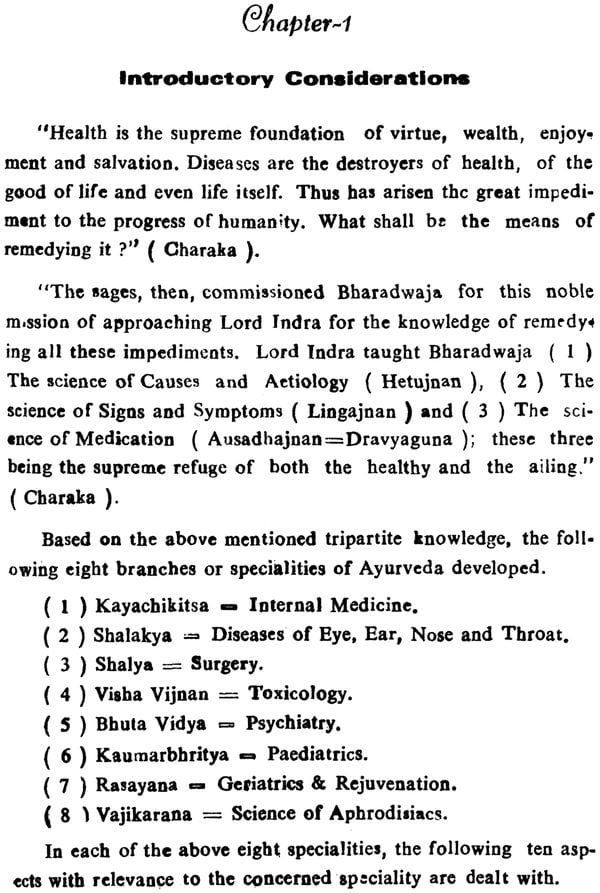
RASA-PANCHAKA: (Ayurvedic Principles of Drug-Action)
Book Specification
| Item Code: | IDG226 |
| Author: | Dr. S. C. Dhyani |
| Publisher: | Chowkhamba Krishnadas Academy |
| Language: | English |
| Edition: | 2003 |
| ISBN: | 9788121801257 |
| Pages: | 162 |
| Cover: | Paperback |
| Other Details | 8.5"X5.5" |
| Weight | 150 gm |
Book Description
Foreword:
Despite rapid advancing theories in modern pharmacology; much remains to be said about Drug versus Disease, pharmacokinestics, bio-transformation, selective affinity of drugs to a particular cell or system and so on. Ayurvedic pharmacological principles offer new fields of research and re-orient the basis of drug-therapy.
There is much similarity in the Ayurvedic and modern pharmacology. Various factors influence the drug-action at the molecular level and even though the exact mechanism of drug-action is not yet fully known to modern pharmacology, they explain it one the basis of ionisation, polarity, inter atomic distances, stearic structure and isomerism, which fairly correspond to Rasa, Vipaka, Guna, Veerya and Prabhava, respectively.
| Page No. | ||
| 1. Introductory Considerations | ||
| Definition and scope of Dravya | 5 | |
| How the drug acts? | 6 | |
| Actions or Effects of Drugs | 7 | |
| Potency of Drugs | 9 | |
| Pharmacokintetics | 11 | |
| Site of action | 13 | |
| Route of administration | 15 | |
| Time of drug administration | 17 | |
| Mode of action | 18 | |
| Vriddhi and Kshaya | 19 | |
| Poshyabhava-Poshakabhava-Agni | 21 | |
| Local, General and Remote actions | 22 | |
| Elective Affinity of Drugs | 23 | |
| Results of Drug Therapy | 24 | |
| Drug Therapy | 25 | |
| Anupana (Vehicle) | 30 | |
| 2. Treat the man as a whole and Give the drug as a whole | 32 | |
| Treat the man as a whole | 32 | |
| Give the drug as a whole | 37 | |
| 3. Rasa Definition-Description-Determination | 43 | |
| Review of Literature | 43 | |
| 4. The origin of six Rasas Vis a Vis The origin of life | 46 | |
| i Cycle of the evolution of Rasas | 48 | |
| i Cycle of Rasas | 48 | |
| ii Cycle of Rasas | 52 | |
| iii Cycle of Rasas (Physiological Cycle) | 52 | |
| The importance of the Rasas | 55 | |
| Definition of Rasa | 56 | |
| The kinds or number of taste | 56 | |
| Specific characteristic of Six Rasas | 61 | |
| Amla Rasa | 62 | |
| Actions of Amla | 62 | |
| Lavana Rasa | 63 | |
| Katu Rasa | 63 | |
| Tikta Rasa | 64 | |
| Kashaya Rasa | 64 | |
| The mechanism of taste | 65 | |
| Problems | 65 | |
| Solutions to the problems | 65 | |
| Tables showing the Rasa of drugs | 66 | |
| Method to determine the Taste-threshold | 68 | |
| Classification of the intensity of taste | 76 | |
| Ecological effects on taste-threshold | 86 | |
| 5. Vipaka (Determination of digestion and metabolism of substances) | 88 | |
| Definition of Vipaka | 89 | |
| Avasthapaka and Nisthapaka | 89 | |
| Kinds of Vipaka | 90 | |
| Trividha Vipaka | 92 | |
| Vipaka at the level of Agnis | 94 | |
| How to determine Vipaka | 96 | |
| Practical works and conclusions | 97 | |
| 6. Gunas (Qualities of drugs) | 99 | |
| Guna | 101 | |
| Definition of Guna | 101 | |
| Adhyatmika Gunas | 101 | |
| Gurvadi Gunas | 102 | |
| Paradi Gunas | 102 | |
| Visista Gunas | 102 | |
| Twenty Sharira gunas and Six types of Treatment | 107 | |
| Santarpana Treatment | 107 | |
| Apatarpana Treatment | 107 | |
| 7. Veerya (Potency of drugs) | 110 | |
| Definition and scope of Veerya | 111 | |
| Kinds of Veerya | 112 | |
| How to determine Veerya | 114 | |
| Some experimental studies on Veerya | 118 | |
| 8. Prabhava and Medicaments | 123 | |
| 9. Medicaments (Identification of drugs, assessment of their | ||
| properties & evaluation of their actions) | 127 | |
| Name and N. O. of drugs | 129 | |
| Controversy in Identification | 131 | |
| Physical and chemical properties | 131 | |
| Therapeutic actions | 132 | |
| Habitat | 135 | |
| Method of preservation | 136 | |
| Pharmaceutical processing of it's preparation | 136 | |
| Dosage | 136 | |
| Clinical trials and results | 137 | |
| Trials on healthy volunteers and patients | 138 | |
| Gorakhaganja (Avera lanata) | 140 | |
| When a drug is given, a risk is taken | 141 | |
| 10. Alphabetic list of drugs and their parts used | 144 | |













